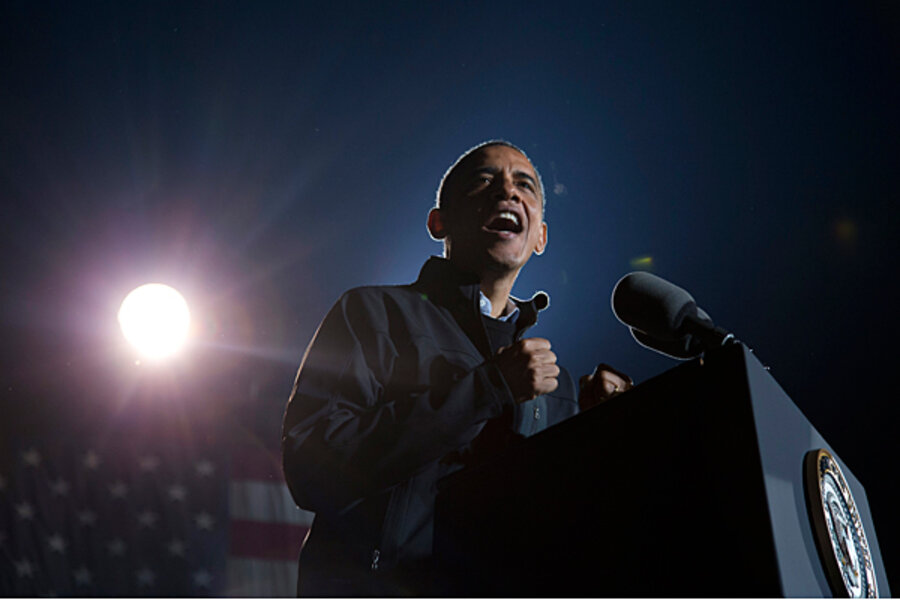Election Day: Does Obama have the edge?
Loading...
| Washington
It’s Election Day, and the final polls are in. If the outcome were to be decided by the popular vote, it would be too close to call. The Real Clear Politics average of the latest national polls shows President Obama ahead by just 0.7 percentage points. That’s way within the margin of error.
But the winner will be determined by the Electoral College, not the popular vote. And by that score Mr. Obama seems to have a slight edge over Republican challenger Mitt Romney.
If each tossup state is assigned to the candidate toward whom it is leaning, according to the averages of each state’s recent polls, then Obama could win the Electoral College handily. The Real Clear Politics map with no tossup states gives Obama 303 electoral votes versus 235 for Mr. Romney. To win, a candidate needs 270 votes.
But that Real Clear “no tossup map” gives a lot of credence to those state polls, and when averaged, they’re all close. (That’s why they’re battleground states!) If the turnout assumptions in those polls end up underestimating the motivation level of Romney voters then they could be wrong.
Conservative political analyst Michael Barone says the fundamentals work in Romney’s favor. Most voters oppose Obama’s major policies and are unhappy with the sluggish economic recovery, he writes in the Washington Examiner. National and “target state” polls show independents breaking for Romney, he adds.
“That might not matter if Democrats outnumbered Republicans by 39 percent to 32 percent, as they did in the 2008 exit poll,” writes Mr. Barone, a resident fellow at the American Enterprise Institute. “But just about every indicator suggests that Republicans are more enthusiastic about voting – and about their candidate – than they were in 2008, and Democrats are less so.”
So unlike a lot of the other handicappers, he puts Nevada, Wisconsin, Pennsylvania, Minnesota, and most important, Ohio, in the Romney column. Barone’s bottom line: Romney 315, Obama 223.
Romney could lose some of those states and still win the election, but he can’t lose Ohio. The hype is true: Ohio really is the firewall for Obama. And some Republicans are less confident about Ohio than Barone. Ford O’Connell, head of the conservative Civic Forum PAC, says that while the enthusiasm is there for Romney in southern Ohio – coal country, where Environmental Protection Agency regulations are unpopular – Romney continues to struggle across the northern part of the state.
“For some reason – whether it’s the auto bailout or whatever – he [Romney] cannot seem to get what he needs to get with white working-class voters between Toledo and Akron,” says Mr. O’Connell.
Romney has made a late play for Pennsylvania, as a way to survive a loss in Ohio, but if neither of those states goes into his column, another option is Wisconsin. But the polls look even less favorable there.
And unless there’s an across-the-board shift toward Romney of about two percentage points, he may find that 270 is a bridge too far.
On Monday, other handicappers came out with predictions of an Obama victory. In his final “Crystal Ball” rating, University of Virginia political scientist Larry Sabato gives Romney the southeastern swing states – Florida, North Carolina, and Virginia – but none of the other remaining battlegrounds. That puts Obama at 290 electoral votes to Romney’s 248.
“This has been a roller-coaster campaign, though very tight ever since Romney dramatically outshone Obama in the first debate in Denver on Oct. 3,” write Mr. Sabato and coauthors Kyle Kondik and Geoffrey Skelley.
“Yet for a challenger to defeat an incumbent, the fates must be with the challenger again and again,” they continue. “Who could have imagined that a Frankenstorm would act as a circuit-breaker on the Republican’s campaign, blowing Romney off center stage for three critical days in the campaign’s last week, while enabling Obama to dominate as presidential comforter-in-chief, assisted by his new bipartisan best friend, Gov. Chris Christie (R)?”
Jack Pitney, a political scientist at Claremont McKenna College in Claremont, Calif., also projects an Obama victory, but by a slightly narrower margin. He gives Colorado to Romney, which puts the Republican at 257 electoral votes to Obama’s 281. On the popular vote, he has Obama squeaking by with 50 percent to Romney’s 49 percent, and 1 percent to other candidates.
“The most likely outcome is that Obama wins the popular and electoral vote,” Mr. Pitney writes.
But the polls could be wrong, he says, either because of sampling errors or other problems with polls. The Pew Research Center’s final poll, released Nov. 4, has Obama leading Romney 48 percent to 45 percent – a shift toward Obama due partly to his handling of the aftermath of hurricane Sandy. But Pitney points to Pew director Andrew Kohut’s caveat that “undecideds and switchers” could alter the outcome.
"We still have 11 percent of the sample saying 'we could possibly change our mind,’ ” Kohut told NPR. “This is our projection, and our projections have been pretty good, but there's always the possibility things could change."
The Pew analysis also raises hope for Barone’s point – that Romney voters are more enthusiastic than Obama voters, and could bring about an Election Day upset.
“Voter turnout, which may be lower than in 2008 and 2004, remains one of Romney’s strengths,” Pew reports in its final analysis. “Romney’s supporters continue to be more engaged in the election and interested in election news than Obama supporters, and are more committed to voting.”
Bottom line: This race isn’t over.








